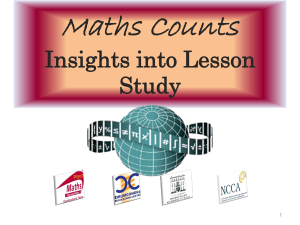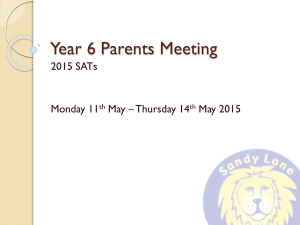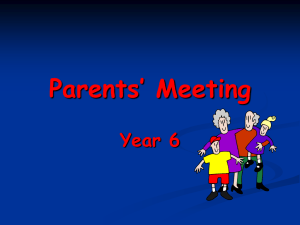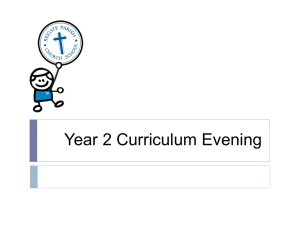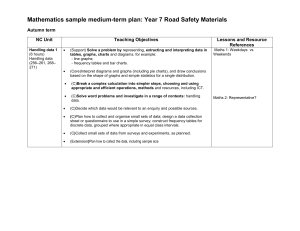Patterns for Junior Cert. Loretto Abbey, Dalkey
advertisement
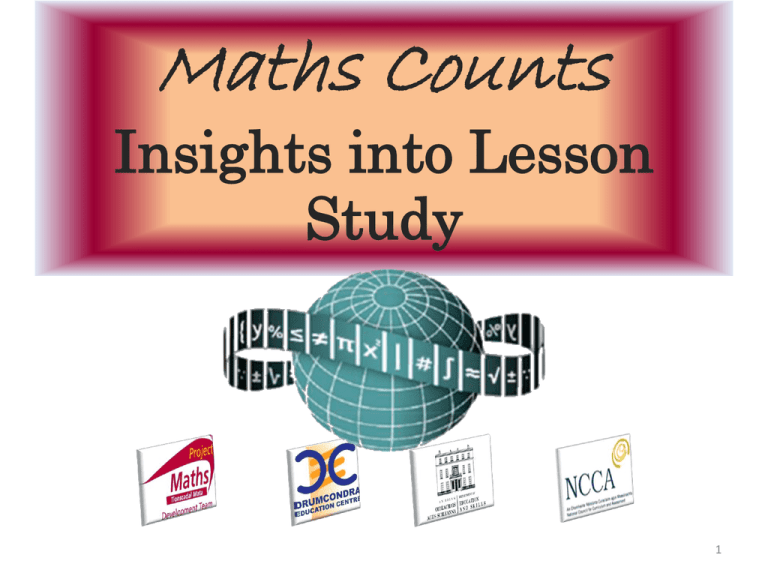
Maths Counts Insights into Lesson Study 1 • Moate Community School: Mathematics Department • Target Group: Junior Cycle • Topic: Introducing Patterns – Second Year 2 • Introduction: Focus of Lesson • Student Learning : What we learned about students’ understanding based on data collected • Teaching Strategies: What we noticed about our own teaching • Strengths & Weaknesses of adopting the Lesson Study process 3 • Topic investigated : Introduction to Patterns • How we planned the lesson: • Meetings and discussions with maths department • It was decided to give priority to new material on syllabus, in this case “Patterns” • Resources used • Internet • Developed our own questions 4 • Learning Outcomes – use tables to represent a repeating-pattern situation – generalise and explain patterns and relationships in words and numbers – write arithmetic expressions for particular terms in a sequence – use tables, diagrams and graphs as tools for representing and analysing patterns and relations – develop and use their own generalising strategies and ideas and consider those of others – present and interpret solutions, explaining and justifying methods, inferences and reasoning – find the underlying formula written in words from which the data is derived (linear relations only) 5 • Why did we choose to focus on this mathematical area? • It’s a new topic on the syllabus; as teachers, we decided it was important that we became more comfortable/familiar with the material and the desired learning outcomes. • As we had never taught this topic before, we were also keen to explore various methodologies which might enhance the understanding of the topic for students. 6 Enduring understandings What we wanted the students to “get” • Answer the question actually asked (not the one they would like to be asked) • Help the students to develop “stay-ability” and “self start” practices with unfamiliar questions • Obviously, we wanted students to develop Problem Solving Skills • Finally, by the end of the session, we hoped that students would begin to see connections between different mathematical topics, e.g. Patterns Coordinate geometry Slope, etc. 7 • Student Learning : What we learned about students’ understanding based on data collected • Teaching Strategies: What we noticed about our own teaching 8 • Data Collected from the Lesson: 1. Academic, e.g. samples of students’ work 2. Motivation 3. Social Behaviour 9 • What we learned about the way different students understand the content of this topic? We discovered students learned most effectively when – content was introduced slowly - “one step at a time” – they were able to visualise the problem (e.g. drawing graphs & tables) – they were able to discuss the problem/story in class and relate it to real life experience 10 • What effective understanding of this topic looks like: • So, what did the students do that showed “me” as a teacher that they understood the topic • Asked lots of questions to try and make sense of the problem in their own mind • Were able to graphically represent the problem, i.e. move from words/text to images • Were able to explain the problem in their own words, and thus created a word representation (equation) without even realising that they had done this 11 • Misconceptions/ Knowledge Gap • Students struggled with the concept of “Day 0” and “Day 1” when creating a table/ pattern. • Students had studied the Cartesian plane in first year, and we assumed that they knew how to graph lines in the positive quadrant in the plane – however, we were mistaken, and had to recap on basic graphing skills and concepts (scales, distance, etc). • Slope (as a rate of change) had to be discussed. 12 • What's the error here? Incorrect scaling of the y-axis 13 • What's the error here? Axes not labelled, y-axis a different scale to x-axis, Student may think their answer is incorrect, but is it? 14 Graph not labelled 15 • What's the error here? Axis (y) labelled incorrectly (inverted) 16 Incorrect scale chosen for y-axis. Points plotted incorrectly. Student failed to recognise graph should be linear, based on data from table 17 No day 0 used “Start Amount” 18 • Recommendations The adjustments I would make in the future – Ensure students have good knowledge of graphs – Ensure students understand concept of slope as a rate of change – Spend a little more time discussing starting value (e.g. difference between day 0 and day 1) – The first time: I provided “Project Title”, however, this year, students had to create and decide on their own Project Title 19 • The understandings we gained regarding students’ learning Patterns as a result of being involved in the research lesson • Students need to be introduced to this topic slowly at the start; once they understand the basic concepts they are able to link all sections of the topic together. • It is important to allow students to initiate discussion with teacher/each other regarding various parts of the topic, e.g. “What does this mean?”, “How come?”, “What would happen if…?” • Discovered that students used a variety of methods and discussion amongst each other to arrive at the same answer, without teacher “guidance”, e.g. tables, graphs, equations all used to discover a solution. 20 • What did we learn about this content to ensure we had a strong conceptual understanding of this topic? • The first time we (teachers) saw this topic, we noticed that there were 2 different ways to teach patterns, depending on how the question was phrased (e.g. Number form: complete the sequence 1,4,9,16... ). However, we also encountered “Story Problems” which required us to develop a different teaching strategy. • We had to do extra research to ensure we had a concrete understanding of what the syllabus meant by “Patterns”; this lead to a lot of discussion within the maths dept. 21 What did I notice about my own teaching? • What was difficult? • Initially it was more difficult, because: • Normally maths involved finding a formula and “subbing in” information. This “standardised” form of questioning was now removed. • Students (and myself) needed a much deeper understanding of the topic and be able to relate it to concrete situations • Sometimes it was difficult to find the source of a student’s misconception. • This took a lot more preparation time than normal as the formula had to match with the graph and errors would confuse students. • If an initial misconception took root, it was difficult to get students to “un-learn” the mistake. 22 • • • • What did I notice about my own teaching? BUT… Once the students (and myself) developed a solid understanding of the concepts involved, the subject became much easier to teach, with very few errors experienced. Students began to enjoy the topic. They developed more “stay-ability” and “self start” initiative when faced with unfamiliar questions (stories). As a teacher I noticed that I was engaged in a lot more discussion with the students regarding the maths and its understanding. 23 • Was it difficult to facilitate and sustain communication and collaboration during the lesson? • Initially, yes, but as students gained understanding they grew in confidence and collaboration and communication improved greatly. • As we progressed through the topic, the lesson became more “student led” and there were numerous student discussions on the best/most efficient way to solve a problem. 24 • Was it difficult to ask questions to provoke students’ deep thinking? • This particular topic lends itself very well to higher order questions. So it wasn’t difficult. 25 • How did I engage and sustain students’ interest and attention during the lesson? I provided questions that students could relate to and were interested in, e.g. Mobile Phone tariffs/ concert tickets, and set an assessment at the end where students had to complete a project and were allowed to choose their own topic (e.g. One Direction V Little Mix). 26 27 28 29 30 • How did I assess what students knew and understood during the lesson? • During class time – Initiate discussion • Students had to create a “Story” around a graph • Class test based on previous exam papers • Group Work: Project which was 20% of midterm exam 31 • How did I put closure to the lesson? • Asked the students to summarise the main points of the topic • Short Class test • Students were required to complete (and present to peers) a project on the topic 32 • What understandings have I developed regarding teaching strategies for this topic as a result of my involvement in Lesson Study? • It is important to allow students to discuss the topic; this made it much easier to identify misconceptions. • Increase “wait-time” when looking for an answer from students. • Ask more thought-provoking questions during the lesson. • Ensure that I am very familiar with the topic. • Discuss/ reflect on the lesson with other colleagues in the maths department. • When setting assignments, students were far more engaged if the problems could be related to concrete situations in real life. • Flag improvements which could be made for the next time I teach this topic. 33 • What changes would I make in the future, based on what I have learned in my teaching, to address students’ misconceptions? • Initial introduction of the topic is very important; spend some extra time (if needed) here to ensure students develop a solid understanding of basic concepts. • Check with the students what they already know (don’t assume that because it has been previously covered everyone understands it, e.g. basic graphing skills). • Don’t automatically tell the student where they have made an error; initiate discussion as to where/what the error might be. • Encourage group work, peer-peer learning for students. • Set assignments (e.g. mini project) where students must present their findings to the class; this improves standard of work received and promotes high levels of discussion. 34 Strengths & Weaknesses As a mathematics team how has Lesson Study impacted on the way we work with other colleagues? • We collaborate a lot more • Share EVERY resource we have with each other • Created “Dropbox” to centralise electronic resources, also on school server • Discuss maths more (a LOT more!!) 35 • • • • Strengths & Weaknesses Personally, how has Lesson Study supported my growth as a teacher? I try to put every question into some relevant context for the students I research maths a lot more than I used to, to help me find fresh ideas and approaches for use when teaching I tend to reflect more on how lessons went (e.g. student interaction and discussion levels) 36 Strengths & Weaknesses • Recommendations as to how Lesson Study could be integrated into a school context • Share our experience with other subject departments. • Schools could set up a central repository (online) where all resources can be stored, added to and accessed by teachers. 37
